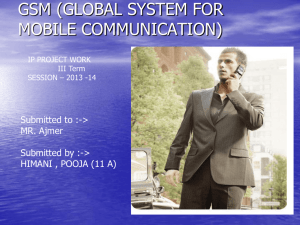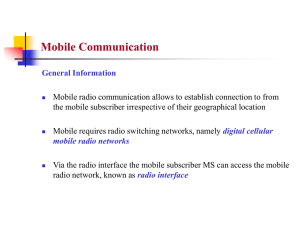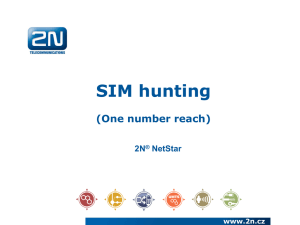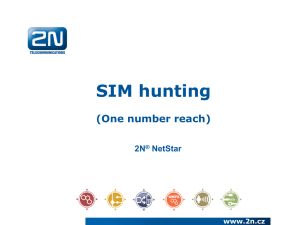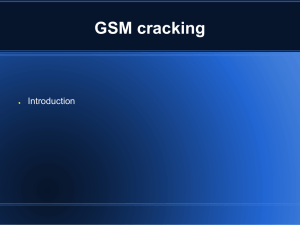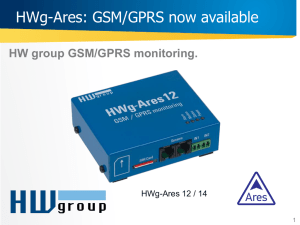MSC
advertisement
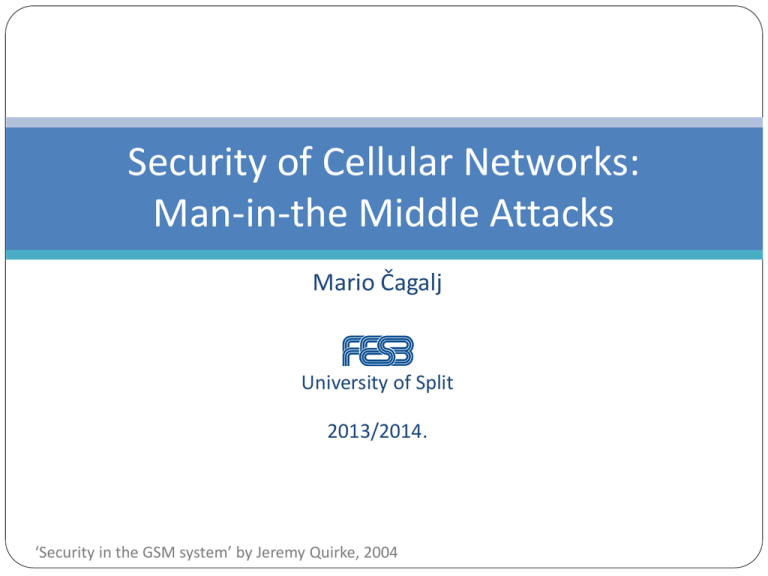
Security of Cellular Networks: Man-in-the Middle Attacks Mario Čagalj University of Split 2013/2014. ‘Security in the GSM system’ by Jeremy Quirke, 2004 Introduction Nowadays, mobile phones are used by 80-90% of the world’s population (billion of users) Evolution 1G: analog cellular networks GSM security specifications 2G: digital cellular networks with GSM (Global System for Mobile Communications) beign the most popular and the most widely used standard (circuit switching) other 2G: technologies IS-95 – CDMA based (US), PDC (Japan), etc. 2.5G: GPRS (General Packet Radio Service) – packet switching 2.75G: EDGE – faster data service 3G: UMTS (CDMA based), HSPA for data traffic (e.g., 5-10 Mbps) other 3G: CDMA2000 (US, S. Korea) 4G: LTE (OFDM based), peak data rates of 100Mbps 2 Cellular Network Architecture A high level view Databases (e.g., Home Location Register) Mobile Station Base Station Mobile Switching Center External Network Cellular Network EPFL, JPH 3 Cellular Network Architecture Registration Process Nr: 079/4154678 Tune on the strongest signal EPFL, JPH 4 Cellular Network Architecture Service Request 079/4154678 079/8132627 EPFL, JPH 079/4154678 079/8132627 5 Cellular Network Architecture Paging Broadcast (locating a particular mobile station in case of mobile terminated call) 079/8132627? 079/8132627? 079/8132627? 079/8132627? Note: paging makes sense only over a small area EPFL, JPH 6 Cellular Network Architecture Response 079/8132627 079/8132627 EPFL, JPH 7 Cellular Network Architecture Channel Assignement Channel 47 Channel 47 Channel 68 Channel 68 EPFL, JPH 8 Cellular Network Architecture Conversation EPFL, JPH 9 Cellular Network Architecture Handover (or Handoff) EPFL, JPH 10 Cellular Network Architecture Message Sequence Chart Base Station Caller Base Station Switch Periodic registration Service request Paging broadcast Tune to Ch.47 Ring indication Stop ring indication EPFL, JPH Callee Periodic registration Service request Page request Page request Paging broadcast Assign Ch. 47 Paging response Paging response Assign Ch. 68 Tune to Ch. 68 Alert tone Ring indication Stop ring indication User response User response 11 GSM System Architecture Based on ‘Mobile Communications: Wireless Telecommunication Systems’ Architecture of the GSM system GSM is a PLMN (Public Land Mobile Network) several providers setup mobile networks following the GSM standard within each country components MS (mobile station) BS (base station) MSC (mobile switching center) LR (location register) subsystems RSS (radio subsystem): covers all radio aspects NSS (network and switching subsystem): call forwarding, handover, switching OSS (operation subsystem): management of the network 13 Please check http://gsmfordummies.com/architecture/arch.shtml GSM: overview OMC, EIR, AUC HLR NSS with OSS VLR MSC GMSC VLR fixed network MSC BSC BSC RSS 14 GSM: system architecture radio subsystem MS network and switching subsystem fixed networks MS ISDN PSTN MSC BTS BSC EIR SS7 BTS HLR VLR BTS BSC BTS BSS MSC IWF ISDN PSTN PSPDN CSPDN 15 System architecture: radio subsystem radio subsystem MS network and switching subsystem Components MS (Mobile Station) MS BSS (Base Station Subsystem): consisting of BTS (Base Transceiver Station): BTS BTS BSC MSC BSC MSC BTS BTS sender and receiver BSC (Base Station Controller): controlling several transceivers BSS 16 Radio subsystem The Radio Subsystem (RSS) comprises the cellular mobile network up to the switching centers Components Base Station Subsystem (BSS): Base Transceiver Station (BTS): radio components including sender, receiver, antenna - if directed antennas are used one BTS can cover several cells Base Station Controller (BSC): switching between BTSs, controlling BTSs, managing of network resources, mapping of radio channels onto terrestrial channels Mobile Stations (MS) 17 GSM: cellular network segmentation of the area into cells possible radio coverage of the cell cell idealized shape of the cell use of several carrier frequencies not the same frequency in adjoining cells cell sizes vary from some 100 m up to 35 km depending on user density, geography, transceiver power etc. hexagonal shape of cells is idealized (cells overlap, shapes depend on geography) if a mobile user changes cells handover of the connection to the neighbor cell 18 System architecture: network and switching subsystem network subsystem fixed partner networks ISDN PSTN MSC SS7 EIR HLR VLR MSC IWF ISDN PSTN PSPDN CSPDN Components MSC (Mobile Services Switching Center) IWF (Interworking Functions) ISDN (Integrated Services Digital Network) PSTN (Public Switched Telephone Network) PSPDN (Packet Switched Public Data Net.) CSPDN (Circuit Switched Public Data Net.) Databases HLR (Home Location Register) VLR (Visitor Location Register) EIR (Equipment Identity Register) 19 Network and switching subsystem NSS is the main component of the public mobile network GSM switching, mobility management, interconnection to other networks, system control Components Mobile Services Switching Center (MSC) controls all connections via a separated network to/from a mobile terminal within the domain of the MSC - several BSC can belong to a MSC Databases (important: scalability, high capacity, low delay) Home Location Register (HLR) central master database containing user data, permanent and semi-permanent data of all subscribers assigned to the HLR (one provider can have several HLRs) Visitor Location Register (VLR) local database for a subset of user data, including data about all user currently in the domain of the VLR 20 Mobile Services Switching Center The MSC (mobile switching center) plays a central role in GSM switching functions additional functions for mobility support management of network resources interworking functions via Gateway MSC (GMSC) integration of several databases 21 Operation subsystem The OSS (Operation Subsystem) enables centralized operation, management, and maintenance of all GSM subsystems Components Authentication Center (AUC) generates user specific authentication parameters on request of a VLR authentication parameters used for authentication of mobile terminals and encryption of user data on the air interface within the GSM system Equipment Identity Register (EIR) registers GSM mobile stations and user rights stolen or malfunctioning mobile stations can be locked and sometimes even localized Operation and Maintenance Center (OMC) different control capabilities for the radio subsystem and the network subsystem 22 Please check http://gsmfordummies.com/gsmevents/mobile_terminated.shtml Mobile Terminated Call 1: calling a GSM subscriber HLR 2: forwarding call to GMSC 3 6 3: signal call setup to HLR 4, 5: request MSRN (roaming number) from VLR calling station 1 PSTN 2 GMSC 6: forward responsible MSC to GMSC 7: forward call to current MSC 8, 9: get current status of MS 10, 11: paging of MS 4 5 10 7 VLR 8 9 14 15 MSC 10 13 16 10 BSS BSS BSS 11 11 11 11 12 17 MS 12, 13: MS answers 14, 15: security checks 16, 17: set up connection 23 Mobile Originated Call 1, 2: connection request 3, 4: security check VLR 5-8: check resources (free circuit) 9-10: set up call 3 4 PSTN 6 GMSC 7 5 8 MS 1 10 MSC 2 9 BSS 24 Mobile Terminated and Mobile Originated Calls MS MTC BTS MS MOC BTS paging request channel request channel request immediate assignment immediate assignment paging response service request authentication request authentication request authentication response authentication response ciphering command ciphering command ciphering complete ciphering complete setup setup call confirmed call confirmed assignment command assignment command assignment complete assignment complete alerting alerting connect connect connect acknowledge connect acknowledge data/speech exchange data/speech exchange 25 Security in GSM Based on: ‘Security in the GSM system’ by Jeremy Quirke ‘The GSM Standard (An overview of its security)’ by SANS Institute InfoSec Reading Room ‘Mobile Communications: Wireless Telecommunication Systems’ Security Services in GSM Access control/authentication x user <-- -- SIM (Subscriber Identity Module): secret PIN (personal identification number) x SIM <-- -- network: challenge response method Confidentiality voice and signaling encrypted on the wireless link (after successful authentication) Anonymity temporary identity TMSI (Temporary Mobile Subscriber Identity) newly assigned at each new location update (LUP) encrypted transmission 27 Security Services in GSM Authentication SIM (Subscriber Identity Module) card smartcard inserted into a mobiel phone contains all necessary details to obtain access to an account unique IMSI (International Mobile Subscriber Identity) Ki - the individual subscriber authentication key (128bit, used to generate all other encryption and authentication keying GSM material) highly protected – the mobile phone never learns this key, mobile only forwards any required material to the SIM known only to the SIM and network AUC (Authentication Center) SIM unlocked using a PIN or PUK authentication (A3 algorithm) and key generation (A8 algorithm) is performed in the SIM SIM contains a microprocessor 28 Security Services in GSM Authentication SIM mobile network Ki AC RAND 128 bit RAND 128 bit RAND 128 bit A3 Ki 128 bit A3 SIM SRES* 32 bit MSC SRES* =? SRES SRES 32 bit SRES 32 bit SRES Ki: individual subscriber authentication key SRES: signed response 29 Security Services in GSM Authentication Kc: Session encryption key generated together with SRES 30 Security Services in GSM Encryption MS with SIM mobile network (BTS) Ki AC RAND 128 bit RAND 128 bit RAND 128 bit A8 cipher key BTS Ki 128 bit SIM A8 Kc 64 bit Kc 64 bit data A5 encrypted data SRES data A5 MS 31 Security Services in GSM Authentication and Encryption A3 and A8 algorithms are both run in SIM at the same time on the same input (RAND, Ki) A3A8 = COMP128v1, COMP128v2, COMP123v3 (serious weaknesses known) not used in UMTS Encryption algorithm A5 symmetric encryption algorithm voice/data encryption performed by a phone using generated encryption key Kc 32 Security Services in GSM Encryption A5 algorithms A5/0 – no encryption used A5/1 and A5/2 developed far from public domain and later found flawed stream ciphers based on linear feedback shift registers A5/2 completely broken (not used anymore in GSM) A5/1 is a bit stronger but also broken by many researchers A5/3 – is a block cipher based on Kasumi encryption algorithm used in UMTS, GSM, and GPRS mobile communications systems public and reasonably secure (at least at the moment) 33 Security Services in GSM Summary 34 Security Weaknesess in GSM A mobile phone does not authenticate the base station! only mobile authenticate to BS (one-way authentication) fake BS and man-in-the middle attacks possible attacker does not have to know authentication key Ki A5/0 - No Encryption algorithm is a valid choice in GSM for voice, SMS, GPRS, EDGE services Many weaknesses in A5 family of encryption algorithms 35 Security Weaknesess in GSM 36 Security Services in GSM Anonymity Preventing eavesdropper (listening attacker) from determining if a particular subscriber is/was in the given area location privacy thanks to long ranges a very powerful attack attacker uses IMSI (International Mobile Subscriber Identity) IMSI Catchers To preserve location privacy GSM defines TMSI (Temporary Mobile Subscriber Identity) when a phone turned on, IMSI from SIM transmitted in clear to the AUC after this TMSI is assigned to this user for location privacy after each location update or a predefined time out, a new TMSI is assigned to the mobile phone a new TMSI is sent encrypted (whenever possible) VLR database contains mapping TMSI to IMSI 37 Security Services in GSM Anonymity 38 Security Services in GSM Anonymity 39 Security Weaknesess in GSM Attack Against the Anonymity Service GSM provisions for situation when the network somhow loses track of a particular TMSI in this case the network must ask the subscriber its IMSI over the radio link using the IDENTITY REQUEST and IDENTITY RESPONSE mechanism however, the connection cannot be encrypted if the network does not know the IMSI and so the IMSI is sent in plain text the attacker can use this to map known TMSI and unknown and user-specific IMSI 40 Countermeasures: UMTS UMTS defines 2-way authentication and mandates the use of stronger encryption and authentication primitives prevents MITM attacks by a fake BS, but be cautious... Still many reasons to worry about most mobiles support < 3G standards (GPRS, EDGE) when signal is bad, hard to supprot UMTS rates mobile providers already invested a lot of money and do not give up upon ‘old’ BSS equippment femtocells 41 Many Reason to Worry About Your Privacy http://www.theregister.co.uk/2008/05/20/tracking_phones/ http://www.theregister.co.uk/2011/10/31/met_police_datong_mo bile_tracking/ (check also http://www.pathintelligence.com) http://docs.google.com/viewer?url=https%3A%2F%2Fmedia.black hat.com%2Fbh-dc-11%2FPerez-Pico%2FBlackHat_DC_2011_PerezPico_Mobile_Attacks-Slides.pdf http://docs.google.com/viewer?url=http%3A%2F%2Ffemto.sec.t- labs.tu-berlin.de%2Fbh2011.pdf 42
